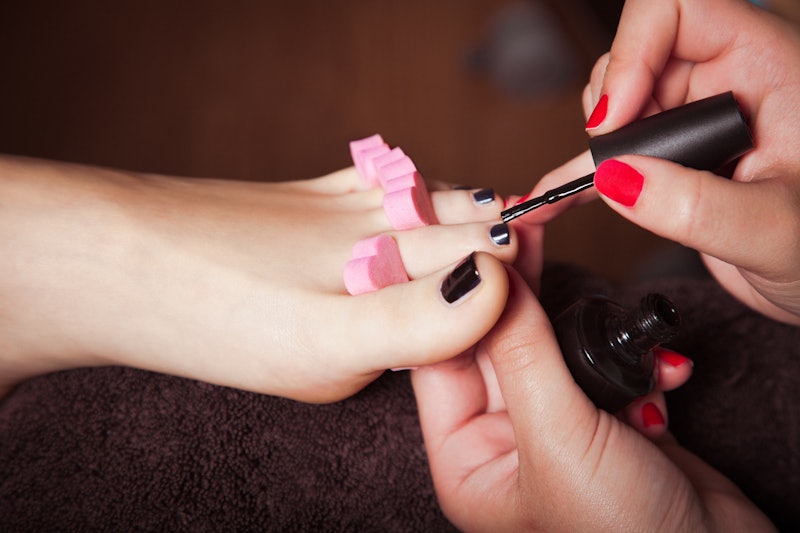Life
If your nails are looking a little off, in terms of color or texture, it may be related to health condition. No matter how much care you may take of your nails — toes and hands — occasionally you can get fungus under nails that can definitely be harder to detect. If you are questioning whether or not you have nail fungus, you'll want to consult your doctor as soon as possible.
As a certified health coach, I recommend people regularly assess their bodies to see if there's anything outside the norm. And, if there is, a doctor's appointment is the next move. So, what's nail fungus exactly? Onychomycosis, a fancy name for nail fungus, can happen when your nails come into contact with fungus, or yeast. This can occur when you've been in a moist environment, during exercise, or sometimes when wearing fake nails, as it's possible for fungus to get stuck under your real nails (and have a pretty easy hiding spot). Well, if you have nail fungus, don't freak out, as it's easy to treat. A few ways? Tsippora Shainhouse, MD, FAAD, a dermatologist in Beverly Hills tells Bustle your best bet is, "[t]rimming back the dead, infected nail. Treating concomitant athletes foot (it goes back and forth from foot to nails all the time), using topical antifungal solutions daily for up to a year, and taking oral antifungal pills." Here are seven signs you might have nail fungus to look out for.
1
You Are Prone To Athlete's Foot
If you've ever had athlete's foot — a common fungal infection that occurs when feet become sweaty and are kept in tight-fitting shoes — or you get it often, you should check those nails out, as you might have fungus hiding underneath. "[Nail fungus] is commonly associated with athletes foot, aka, tinea pedis," says Shainhouse. And you can also go to a doctor for an expert's opinion and diagnosis, too.
2
You've Had A Toenail Infection Recently
If you've had a toenail infection recently, check to make sure there's no fungus remaining, because it could affect your finger nails. "It affects toenails more commonly than fingernails, and fingernail infection is typically preceded by or associated with toenail infection," says Shainhouse. Here's how to know you possibly have a nail infection: there will be pain, redness, and swelling, as well as possible pus, in the infected area.
3
Your Nails Are Yellow
Don't freak out, but if your nails turn yellow, it may be fungus. You'll likely notice "yellowish nail discoloration (sometimes it looks brown or white)," says Shainhouse. It can be small areas of fungus, where "the yellow nail changes begin at the cuticle side of the nail," or it can take over the whole nail, where it's completely yellow, Shainhouse says. It depends on the extremity.
4
Your Nail's Texture Is Crumbly
Cookies are great when crumbly, but nails? Not so much. If you see that "the entire nail plate is affected and looks yellow and crumbly," it's a good sign of fungus, says Shainhouse. This type of "subungual debris (crumbly stuff under the nail)," can get worse unless treated as needed.
5
The Nail Is Lifting
You might notice "onycholysis (aka nail lifting)," says Shainhouse, where "your nail is lifting at the [end], edge, or sides of the nails." This is most common among athletes from exercise strains or shoe discomfort.
6
There's A White, Powder-Like Texture
Of course, while it's common to see yellowness on the nail surface, a discoloration that's more of a white, thick coat may happen, sometimes meaning a fungus. "Some versions will have a white, powdery look on nail surface," says Shainhouse. So, if you get this type of appearance, too, you'll want to get checked out.
7
Your Nail Is Thick
Shainhouse says that you might also notice a thickening of your nails or a more rough, sturdy appearance, especially in toenails, Shainhouse says. If it seems impossible to trim nails, as they are too bulky, you may want to see a doctor for a check up.
If you think that you might have nail fungus, you'll want to get a diagnosis and start the healing process as soon as possible. Letting fungus persist will only make it harder to heal later on. And luckily, treatments are super easy and not invasive.
